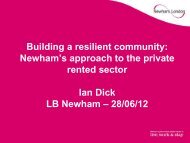View publication - Chartered Institute of Housing
View publication - Chartered Institute of Housing
View publication - Chartered Institute of Housing
You also want an ePaper? Increase the reach of your titles
YUMPU automatically turns print PDFs into web optimized ePapers that Google loves.
PART TWO: LEADING TOMORROW<br />
happening right now. Organisations that are able to adapt to this new way <strong>of</strong> working<br />
will be current and agile, understanding what their customers want; and will be able to<br />
respond to a rapidly changing future.<br />
How technology is changing the future<br />
The influence <strong>of</strong> technology on our lives is growing exponentially. From the way we<br />
shop (with a mobile device you have the high street and a credit card in your hand), to<br />
the way we watch TV (the TV schedule is becoming superfluous) and the way we keep<br />
in touch with family and friends (this is inter-generational).<br />
This influence can be seen across the housing industry. For example, the latest edition <strong>of</strong><br />
<strong>Housing</strong> Technology Magazine (March 2013) 54 includes articles on systems that will<br />
predict and measure rent arrears, provide case studies on flexible mobile working; and<br />
<strong>of</strong>fer systems for collecting and analysing ‘big data’. All these technology driven<br />
measures are aimed at improving performance and cutting costs.<br />
Technology is impacting on the nature <strong>of</strong> work throughout the economy. Process<br />
driven jobs are likely to become automated or outsourced; valued work will be<br />
non-standardised, complex and creative. We <strong>of</strong>ten hear about managing change, but<br />
we are entering an era where everyone will need to be able to thrive in a world <strong>of</strong><br />
constant change.<br />
For housing, the changing political landscape adds an additional layer <strong>of</strong> complexity,<br />
which means delivering on our social business objectives will require a highly skilled<br />
workforce. Becoming a learning organisation will be a key component in developing this<br />
highly skilled workforce. But the traditional view <strong>of</strong> learning is also changing and it is<br />
important to have an understanding <strong>of</strong> this, if we are to develop effective learning<br />
organisations that are fit for the future.<br />
Trends in learning<br />
There are a number <strong>of</strong> key trends in learning that are having a pr<strong>of</strong>ound impact on the<br />
way in which individuals learn, and organisations develop there staff. We will explore<br />
them here:<br />
1. Connectivism – Connectivism is a contemporary approach to learning that has been<br />
promoted by George Siemens 65 and Stephen Downes. 66 It is <strong>of</strong>ten described as the<br />
learning theory for the digital age. Central to this is the premise that knowing how to<br />
140

















